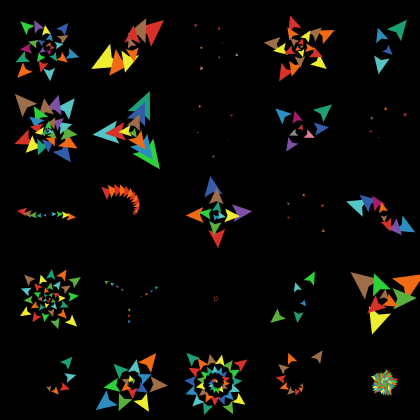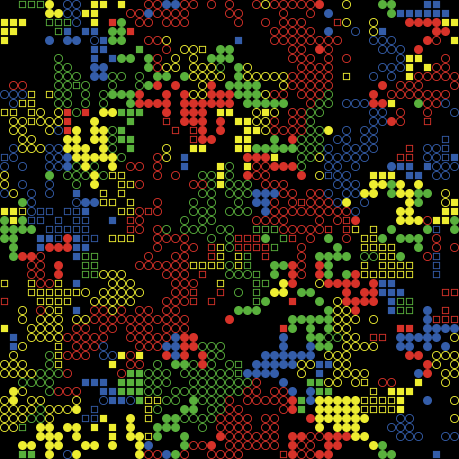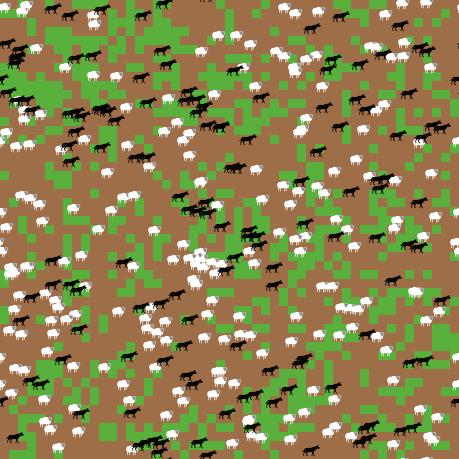BEAGLE
Biological Experiments in Adaptation, Genetics, Learning and Evolution
Overview

Simulated Evolution is the umbrella name for a set of projects focused on using agent-based modeling to explore and learn about evolutionary processes. The central idea of the Simulated Evolution project is to emphasize and manifest that evolution is more than a history of humans, fossils, life, but evolution is a fundamental process – a process by which populations of individuals can change over time through variation and selection. This process applies not only to living things but also to behaviors, strategies, ideas, organizations, even to music and art.
Simulated Evolution projects address the needs of multiple constituencies: Simulated Evolution materials and models are in use in learning communities in both formal and informal settings; but they are also used in research laboratories to elaborate evolutionary theory, and in the media to illustrate and explicate evolutionary processes to the general public.
The Simulated Evolution project’s BEAGLE software (Biological Experiments in Adaptation, Genetics, Learning and Evolution) is specifically designed for learning evolution in both school and non-school settings. BEAGLE consists of a suite of NetLogo models and supporting materials designed to facilitate inquiry, teaching and learning of concepts and phenomena related to evolution, adaptation, and natural and artificial selection. Dozens of models have been developed to explore concepts in evolution and many more are currently under development. Since 1997, BEAGLE models have been used, tested and modified by learners across a wide range of ages in both formal and informal settings. The Simulated Evolution project was formerly called evolab and includes EACH models (Evolution of Cooperative and Altruistic Habits) and other NetLogo models not in BEAGLE.
BEAGLE models let participants open simulations and "play" with them, exploring their behavior under various conditions. The user interface is intuitive enabling students and teachers to easily run simulations and conduct experiments in the virtual evolution laboratory.
The Center for Connected Learning (CCL) has been guided in the development of BEAGLE models by multiple sources including popular science materials, traditional genetics topics, benchmarks for science literacy, reform-based science curriculum units, and current state of the art evolutionary research. Once a new BEAGLE model idea has been identified, we then design and construct a NetLogo model that is vibrant, compelling, and accessible for the young adolescent, but also consistent with the scientific conceptions of a professional evolutionary biologist. Each model includes conceptual scaffolding for a user to begin to interact with it intuitively, explore and run experiments, and also use tools to analyze and dissect model assumptions.
BEAGLE models provide a special opportunity to support the transfer of knowledge between different disciplines and communities, by providing the same low entry level platform for exploring, analyzing, and building models of both simple and complex evolutionary concepts.
BEAGLE Models from the NetLogo Model Library
- Population Dynamics and Ecosystems
- Simple
Birth Rates – Explore simple population dynamics.
- Wolf Sheep Predation – Explore predator/prey population dynamics in a simple ecosystem.
- ECHO – Originally conceived by John Holland, this abstract model of the evolution of ecosystems is both powerful and educational.
- Wolf Sheep Predation – Explore predator/prey population dynamics in a simple ecosystem.
- Artificial Selection
- Sunflower
Biomorphs - Inspired by Dawkin's biomorphs, this model allows
the user to interactively evolve a population of dynamic sunflowers.
- Bird Breeder – Develop a line of fancy birds by performing selective breeding through a careful selection of mates over multiple generations.
- Genetic Drift
- [4 Models]: GenDrift P global -- GenDrift P local -- GenDrift T interact -- GenDrift T reproduce – This sub-suite of models examines the concept of neutral mutation and how evolutionary characteristics drift over time.
- Natural Selection
- Bug
Hunt Camouflage
– Discover how
camouflaging emerges in
a bug population hunted by a predator. (also available as a HubNet
version: Bug
Hunters Camouflage)
- Bug Hunt Speeds - Explore how different predation strategies exert different selective pressures on a population of moving bugs.
- Guppy Spots – Explore how sexual attraction and predation exert selective pressure on the coloration and fin patterns in a population of guppies.
- Peppered Moths – This model is based on the famous example of the change of the coloration of moths in response to pollution.
- Bug Hunt Speeds - Explore how different predation strategies exert different selective pressures on a population of moving bugs.
- Coevolution and Mimicry
- Mimicry
– Examines how a harmless species will take on the physical
characteristics of a poisonous species in order to escape predation
without incurring significant costs.
- Bug Hunt Coevolution – Investigate how interactions between a predator and prey population results in multiple selective pressures that lead to a outcome of interdependent evolution in each population.
- Red Queen – Coevolutionary arms races tend to have only one outcome that each species has to evolve as fast as possible just to maintain their current population. This model examines this phenomenon in the context of toxicology and immunity.

Figure 3: Ethnocentrism Model - Bug Hunt Coevolution – Investigate how interactions between a predator and prey population results in multiple selective pressures that lead to a outcome of interdependent evolution in each population.
- Economic and Behavioral Evolution
- Evolution of Cooperative and Altruistic Habits (EACH) (3
Models: Altruism
-- Cooperation
-- Divide
the Cake ) - This group of models explores concepts like
“success” and “fitness” as emergent phenomenon and how they
affect the behavior of individuals in a population.
- Ethnocentrism – A model of social evolution that explores why ethnocentric behavior (in-group cooperation and out-of-group antagonism) exists.
- El Farol – An example of how evolving economic strategies can result in a stable equilibrium.
- Minority Game Exploration of the co-evolution of strategies within an ecology of strategies
- Degrees of Freedom – This model investigates how the amount of freedom that an agent has to solve problems affects the fitness of that agent, and thus the evolution of that agent over time.
- Ethnocentrism – A model of social evolution that explores why ethnocentric behavior (in-group cooperation and out-of-group antagonism) exists.
- Patterns of Inheritance
- Plant
Hybridization– Explores the patterns of inheritance in
Mendelian genetics with cross-fertilization of plants over multiple
generations.
- Mendel’s Corn Gardener – Explores how Mendelian genetics can be utilized to grow corn with a higher yield.
- Cellular Automata
- Life Turtle Based – This examines the classic Game of Life that illustrates the evolution of dynamic self-reproducing processes.
- Underdevelopment
- Body Segments Evolving – This model allows the individual
to explore how artificial selection and mutation can work together
to create complex body structures.
- Kin Selection – Investigates how the ability to identify and protect kin affects the process of evolution.
- Hardy Weinberg – Investigates how the distribution of dominant and recessive genes changes over time.
- Sickle Cell – Places investigations into dominant and recessive traits within the framework of sickle cell anemia.
Researchers
Project leader - Uri Wilensky
Development team members - Aditi Wagh, Michael Novak
Contact emails - aditiwagh2012@northwestern.edu, mnovak@ccl.northwestern.edu - Kin Selection – Investigates how the ability to identify and protect kin affects the process of evolution.
